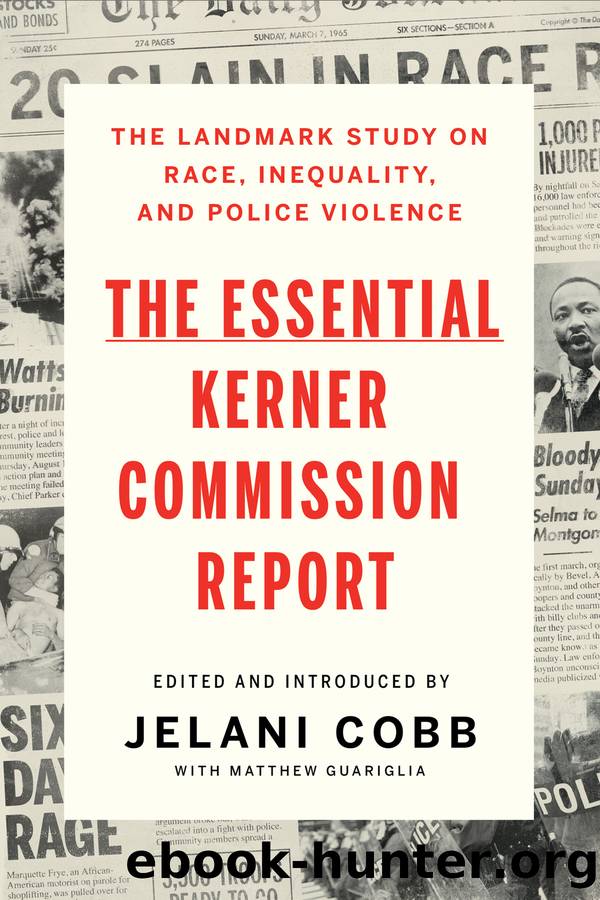The Essential Kerner Commission Report by Jelani Cobb & Matthew Guariglia

Author:Jelani Cobb & Matthew Guariglia [Cobb, Jelani & Guariglia, Matthew]
Language: eng
Format: epub
Tags: history, social history, African American & Black, law, Discrimination, Social Science, Ethnic Studies, American, African American & Black Studies
ISBN: 9781631498930
Google: 9QwDEAAAQBAJ
Publisher: Liveright Publishing
Published: 2021-07-27T23:38:00.138520+00:00
FEDERAL PROGRAMS
What was the pattern of governmental effort to relieve ghetto conditions and to respond to needs in the cities which experienced disorders in 1967?
We have attempted no comprehensive answer to this large and complex question. Instead, we have surveyed only the key Federal antipoverty programs in Detroit, Newark, and New Havenâcities which received substantial Federal funds and also suffered severe disorders.
Among the large number of Federal programs to aid cities, we have concentrated on five types, which relate to the most serious conditions and which involve sizeable amounts of Federal assistance. We have sought to evaluate these amounts against the proportion of persons reached.
We conclude that:
â¢While these three cities received substantial amounts of Federal funds in 1967 for manpower, education, housing, welfare and community action programs, the number of persons assisted by those programs in almost all cases constituted only a fraction of those in need.
â¢In at least 11 of the 15 programs examined (five programs in each of the three cities), the number of people assisted in 1967 was less than half of those in need.
â¢In one of the 15 programs, the percentage rose as high as 72 percent.
â¢The median was 33 percent.
Manpower
Our study included all major manpower and employment programs including basic and remedial education, skill training, on-the-job training, job counseling, and placement.
A 1966 Department of Labor study of 10 slum areas, as well as our own survey of 20 disorder areas, indicates that underemployment may be an even more serious problem for ghetto residents that [sic] unemployment. However, our measurement of need for manpower programs is based on unemployment figures alone because underemployment data are not available for the three cities surveyed. The Department of Labor estimates that underemployment rates in major central-city ghettos are a multiple of the unemployment rate.
In Detroit, during the first three quarters of 1967, Federal funds, obligated in the amount of $19.6 million, provided job training opportunities for less than one-half of the unemployed.
During the first 9 months of 1967, the labor force in Detroit totaled 650,000 persons, of whom 200,000 were Negroes. The average unemployment rate for that period was 2.7 percent for whites and 9.6 percent for Negroes. The total average number unemployed during that period was 31,350, of whom 19,200 (61 percent) were Negroes.
During the same period, there were 22 manpower programs (excluding MDTA institutional programs) in various stages of operation in Detroit. Twenty of the programs provided for 13,979 trainees.
In Newark, in the first half of 1967, $2.6 million of Federal funds provided job training opportunities for less than 20 percent of the unemployed. And in New Haven, during the first three quarters of 1967, Federal funds in the amount of $2.1 million provided job training opportunities for less than one-third of the unemployed.
Education
For purposes of comparing funding to needs, we have limited our examination to two major Federal education programs for the disadvantaged: The Title I program under the Elementary and Secondary Education Act of 1965 (ESEA) and the Adult Basic Education Program. Title I provides
Download
This site does not store any files on its server. We only index and link to content provided by other sites. Please contact the content providers to delete copyright contents if any and email us, we'll remove relevant links or contents immediately.
| Africa | Americas |
| Arctic & Antarctica | Asia |
| Australia & Oceania | Europe |
| Middle East | Russia |
| United States | World |
| Ancient Civilizations | Military |
| Historical Study & Educational Resources |
Machine Learning at Scale with H2O by Gregory Keys | David Whiting(4258)
Never by Ken Follett(3882)
Fairy Tale by Stephen King(3307)
The Man Who Died Twice by Richard Osman(3040)
Oathbringer (The Stormlight Archive, Book 3) by Brandon Sanderson(3021)
Will by Will Smith(2872)
Rationality by Steven Pinker(2327)
The Dark Hours by Michael Connelly(2280)
Can't Hurt Me: Master Your Mind and Defy the Odds - Clean Edition by David Goggins(2276)
Friends, Lovers, and the Big Terrible Thing by Matthew Perry(2182)
The Dawn of Everything: A New History of Humanity by David Graeber & David Wengrow(2156)
Principles for Dealing With the Changing World Order: Why Nations Succeed and Fail by Ray Dalio(2006)
HBR's 10 Must Reads 2022 by Harvard Business Review(1820)
A Short History of War by Jeremy Black(1816)
Go Tell the Bees That I Am Gone by Diana Gabaldon(1731)
A Game of Thrones (The Illustrated Edition) by George R. R. Martin(1662)
515945210 by Unknown(1643)
Kingdom of Ash by Maas Sarah J(1594)
443319537 by Unknown(1522)
